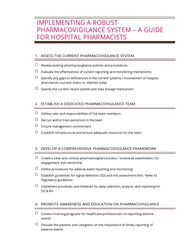
Return to flip book view
IMPLEMENTING A ROBUST PHARMACOVIGILANCE SYSTEM – A GUIDE FOR HOSPITAL PHARMACISTS 1. ASSESS THE CURRENT PHARMACOVIGILANCE SYSTEM ☐ Review existing pharmacovigilance policies and procedures ☐ Evaluate the effectiveness of current reporting and monitoring mechanisms ☐ Identify any gaps or deficiencies in the current systems / involvement of hospital pharmacists (current status vs. desired state) ☐ Specify the current record system and data storage mechanism 2. ESTABLISH A DEDICATED PHARMACOVIGILANCE TEAM ☐ Define roles and responsibilities of the team members ☐ Recruit and/or train personnel in the team ☐ Ensure management commitment ☐ Establish infrastructure and ensure adequate resources for the team 3. DEVELOP A COMPREHENSIVE PHARMACOVIGILANCE FRAMEWORK ☐ Create a clear and concise pharmacovigilance policy / Involve all stakeholders for engagement and ownership ☐ Define procedures for adverse event reporting and monitoring ☐ Establish guidelines for signal detection (SD) and risk assessment (RA) / Refer to Regulatory guidelines ☐ Implement processes and timelines for data collection, analysis, and reporting for SD & RA 4. PROMOTE AWARENESS AND EDUCATION ON PHARMACOVIGILANCE ☐ Conduct training programs for healthcare professionals on reporting adverse events ☐ Educate the patients and caregivers on the importance of timely reporting of adverse events
©2024 PHARMAREAD.COM | All Rights Reserved Page 2 5. ENHANCE REPORTING AND MONITORING MECHANISMS ☐ Implement a user-friendly reporting system / forms for reporting adverse events ☐ Establish mechanism for communication and reporting (e.g., information leaflets, weekly seminars) ☐ Develop a centralized database for collecting and analyzing data in collaboration with other relevant departments and government agency 6. COLLABORATE WITH REGULATORY AUTHORITIES ☐ Establish strong partnerships with regulatory agencies / Drug Regulatory Authority ☐ Establish a regular schedule to share information on adverse events and to highlight safety concerns (a specific product, a specific brand) ☐ Participate in regulatory inspections and audits 7. CONDUCT REGULAR PHARMACOVIGILANCE AUDITS ☐ Review and evaluate the effectiveness of pharmacovigilance systems / Plan a review schedule / Include subject matter experts, qualified and trained team members ☐ Identify areas for improvement and implement corrective actions 8. IMPLEMENT A RISK MANAGEMENT PLAN ☐ Identify potential risks associated with pharmaceutical products (e.g., Sterile products and contamination, special instructions on dose and application) ☐ Develop strategies to mitigate and manage identified risks (coordinate with other stakeholders / healthcare streams 9. ESTABLISH A SYSTEM FOR SIGNAL DETECTION AND EVALUATION ☐ Implement tools and methods for signal detection / Follow regulatory guidance and other tools ☐ Conduct thorough investigation of identified signals
©2024 PHARMAREAD.COM | All Rights Reserved Page 3 10. ENSURE EFFECTIVE COMMUNICATION AND COLLABORATION ☐ Establish regular communication channels with healthcare professionals & regulatory authority ☐ Share important safety information and updates 11. MONITOR AND EVALUATE THE IMPACT OF PHARMACOVIGILANCE SYSTEMS ☐ Track the number of adverse event reports received / Build a time scale of adverse events ☐ Analyze trends and patterns in adverse event data / Use established tools for accurate determinations 12. CONTINUOUSLY IMPROVE PHARMACOVIGILANCE SYSTEMS ☐ Regularly review and update pharmacovigilance policies and procedures ☐ Stay updated with emerging pharmacovigilance trends and best practices 13. ENSURE COMPLIANCE WITH REGULATORY REQUIREMENTS ☐ Stay updated with local and international pharmacovigilance regulations ☐ Adhere to reporting timelines and requirements ☐ Maintain accurate and complete documentation 14. ESTABLISH MECHANISMS FOR QUALITY ASSURANCE ☐ Implement processes for quality control and quality assurance / compliance status, reporting, documentation, etc. ☐ Conduct regular audits to ensure compliance with standards ☐ Take corrective actions to address any identified non-compliance 15. PROMOTE A CULTURE OF PHARMACOVIGILANCE ☐ Foster a culture of safety and reporting within the organization ☐ Recognize and reward individuals for their contributions to pharmacovigilance
©2024 PHARMAREAD.COM | All Rights Reserved Page 4 ☐ Encourage open and transparent communication about adverse events ☐ Participate in medical rounds / listen to patients and caregivers 16. ESTABLISH PARTNERSHIPS WITH HEALTHCARE INSTITUTIONS ☐ Collaborate with other hospital pharmacies and clinics to improve adverse event reporting ☐ Share pharmacovigilance data and insights with healthcare institutions in timely manner ☐ Support healthcare professionals in implementing pharmacovigilance practices / Collaborate with prescribers, medical doctors, technicians, front-line workers (e.g., drug dispensing staff), nurses, etc. Next update: The list will be updated tentatively in September 2024